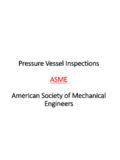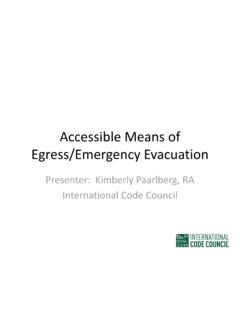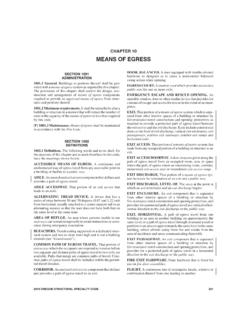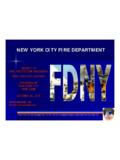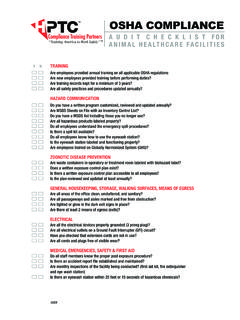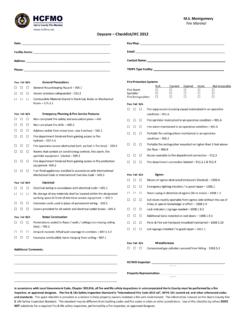Transcription of NAARSO Life Safety Code 2017
1 1/9/20171 NFPA 101 life Safety Code30thAnnual Ride Safety Inspection ForumJanuary 2017 Presented by Ken Berryhill and Nancy HeardHistory of NFPA 101 NFPA 1895 Boston (Factory Mutual, Grinnell Fire Protection, Industrial Risk Insurers) 1913 Committee on Safety to life Issued Pamphlet Exit Drills in Factories, Schools, Department Stores, and Theaters 1927 Building Exits code 1942 Cocoanut Grove Night Club Fire (Boston, 492)History of NFPA 101 1946 Three more fatal fires (Chicago, Dubuque, Atlanta 199) 1963 Title changed to code for Safety to life From Fire in Buildings and Structures 1984 Great Adventure Haunted Castle Fire (Jackson, New Jersey, 8) 2003 Station Night Club Fire (Rhode Island, 100) Added new requirements for nightclubs into NFPA 1011/9/20172 History of NFPA 101 2016 Ghost Ship Warehouse (Oakland, CA 36) Today more than 300 members of 15 technical committees contribute and develop the life Safety code .
2 500 Pages, 43 Chapters, 3 AnnexsHistory of NFPA 101 Currently used in every state and adopted statewide in 43 of NFPA 101 High Rise Structures Tent (Membrane) Structures Assembly Structures Educational Structures Day-Care Facilities Health Care Facilities Detention and Correctional Facilities Hotels, Dormitories, Apartments Mercantile, Business, Industrial1/9/20173 Great Adventure Haunted Castle FireMay 11, 1984 Built in 1978 Constructed of 17 commercial trailers (each about 8 x 40 ) joined together with plywood walkways. Materials used were plywood, foam rubber, fabrics, plastics, and tar paper. Codes not enforced due to temporary structure . Resulted in deaths of 8 Adventure Haunted Castle FireMay 11, 1984 Major factors contributed to loss of life : Failure to detect and extinguish the fire at its incipient stage by means of fixed fire detection and suppression systems, Ignition of synthetic foam materials and subsequent fire and smoke spread involving combustible interior finishes; and Difficulty of escape by occupants based on fire conditions in the haunted house type of 1 Administration Purpose of the code is to provide minimum requirements, with due regard to function, for the design, operation, and maintenance of buildings and structures for Safety to life from fire.
3 Its provisions will also aid life Safety in similar emergencies. ( ) Shall apply to both new construction and existing buildings and existing structures. ( ) Shall apply to vehicles and vessels when used as buildings. ( )Chapter 1 Administration Addresses those construction, protection, and occupancy features necessary to minimize danger to life from the effects of fire, including smoke, heat, and toxic gases created during a fire. ( ) Establishes minimum criteria for the design of egress facilities so as to allow prompt escape of occupants from buildings or, where desirable, into safe areas within buildings. ( )Chapter 3 Definitions Special Amusement Building A building that is temporary, permanent, or mobile and contains a device or system that conveys passengers or provides a walkway along, around, or over a course in any direction as a form of amusement arranged so that the egress path is not readily apparent due to visual or audio distractions or an intentionally confounded egress path, or is not readily available due to the mode of conveyance through the building or structure.
4 ( ) Special amusement buildings include amusements such as a haunted house, a roller coaster type ride within a building, a multilevel play structure within a building, a submarine ride, and similar amusements where the occupants are not in the open air. ( )1/9/20177 Chapter 3 Definitions Assembly occupancy (1) used for a gathering of 50 or more persons for deliberation, worship, entertainment, eating, drinking, amusement, awaiting transportation, or similar uses; or (2) used as a special amusement building, regardless of occupant load. Authority Having Jurisdiction (AHJ). An organization, office, or individual responsible for enforcing the requirements of a code or standard, or for approving equipment, materials, an installation, or a 4 General Number of Means of Egress. Two means of egress, as a minimum, shall be provided in every building or structure, section, and area where size, occupancy, and arrangement endanger occupants attempting to use a single means of egress that is blocked by fire or smoke.
5 The two means of egress shall be arranged to minimize the possibility that both might be rendered impassable by the same emergency condition. Unobstructed Egress. In every occupied building or structure, means of egress from all parts of the building shall be maintained free and unobstructed. Means of egress shall be accessible to the extent necessary to ensure reasonable Safety for occupants having impaired 7 Means of Egress A continuous and unobstructed way of travel from any point in a building or structure to a public way consisting of three separate and distinct parts: (1) the exit access, (2) the exit, and (3) the exit discharge. Exit. That portion of a means of egress that is separated from all other spaces of a building or structure by construction or equipment as required to provide a protected way of travel to the exit discharge.
6 Exit Access. That portion of a means of egress that leads to an exit. Exit Discharge. That portion of a means of egress between the termination of an exit and a public 7 Means of Egress Components. Stairs, Doors, Hardware, Turnstiles, Elevators, Guardrails/Handrails Load Factors, Capacity of Exits In areas not in excess of 10,000 ft2 (930 m2), the occupant load shall not exceed one person in 5 ft2 ( m2). In areas in excess of 10,000 ft2 (930 m2), the occupant load shall not exceed one person in 7 ft2 ( m2). Number of Means of Egress. The number of means of egress from any balcony, mezzanine, story, or portion thereof shall be not less than two, except under one of the following conditions: (1) Occupant load more than 500 but not more than 1000 not less than 3 (2) Occupant load more than 1000 not less than 4 Chapter 7 Means of Egress Arrangement of Means of Egress.
7 Travel Distance to Exits. Illumination of Means of Egress. Emergency Lighting Marking of Means of Egress ElevatorsChapter 12 & 13 Assembly Occupancies New Assembly (Chapter 12) Existing Assembly (Chapter 13) Section 1 General Requirements Section 2 Means of Egress Requirements Section 3 Protection Section 4 Special Provisions Special Amusement Building Section 5 Building Services Elevators, Utilities, HVAC Section 7 - Operating Features Emergency Plans, Drills, Inspections 1/9/20179 Assembly Exits Exit Doors. Any door in a required means of egress from an area having an occupant load of 100 or more persons shall be permitted to be provided with a latch or lock only if the latch or lock is panic hardware or fire exit hardware complying with Door Leaf Swing Direction. Door leaves required to be of the side-hinged or pivoted-swinging type shall swing in the direction of egress travel where serving a room or area with an occupant load of 50 or Travel Distance Travel distance to be measured in accordance with Section Exits shall be arranged so that the total length of travel from any point to reach an exit shall not exceed 200 ft (61 m) in any assembly occupancy, unless in assembly occupancies protected throughout by an approved, supervised automatic sprinkler system.
8 In these cases the travel distance shall not exceed 250 ft (76 m).Assembly Exit Markings Marking of Exits. Exits, other than main exterior exit doors that obviously and clearly are identifiable as exits, shall be marked by an approved sign that is readily visible from any direction of exit access. Door Tactile Signage. Tactile signage shall be provided to meet all of the following criteria, unless otherwise provided in : (1) Tactile signage shall be located at each exit door requiring an exit sign. (2) Tactile signage shall read as follows: EXIT. (3) Tactile signage shall comply with ICC/ANSI , American National Standard for Accessible and Usable Buildings and Facilities. Exit Access. Access to exits shall be marked by approved, readily visible signs in all cases where the exit or way to reach the exit is not readily apparent to the occupants.
9 1/9/201710 Assembly Alarms Initiation. Initiation of the required fire alarm system shall be by both of the following means: (1) Manual means, unless otherwise permitted by one of the following: (a) where initiation is by means of an approved automatic fire detection system that provides fire detection throughout the building. (b) where initiation is by means of an approved automatic sprinkler system that provides fire detection and protection throughout the building. (2) Where automatic sprinklers are provided, initiation of the fire alarm system by sprinkler system waterflow, even where manual fire alarm boxes are provided in accordance with (1)Assembly Alarms The initiating device shall be capable of transmitting an alarm to a receiving station, located within the building, that is constantly attended when the assembly occupancy is occupied.
10 Notification. The required fire alarm system shall activate an audible and visible alarm in a constantly attended receiving station within the building when occupied for purposes of initiating emergency action. Occupant notification shall be by means of voice announcements, initiated by the person in the constantly attended receiving station. Occupant notification shall be by means of visible signals, initiated by the person in the constantly attended receiving Flame Retardant Flame-Retardant Requirements. Combustible scenery of cloth, film, vegetation (dry), and similar materials shall comply with one of the following: (1) They shall meet the flame propagation performance criteria contained in NFPA 701, Standard Methods of Fire Tests for Flame Propagation of Textiles and Films. (2) They shall exhibit a heat release rate not exceeding 100 kW when tested in accordance with NFPA 289, Standard Method of Fire Test for Individual Fuel Packages, using the 20 kW ignition Emergency Plans Emergency Plan.
